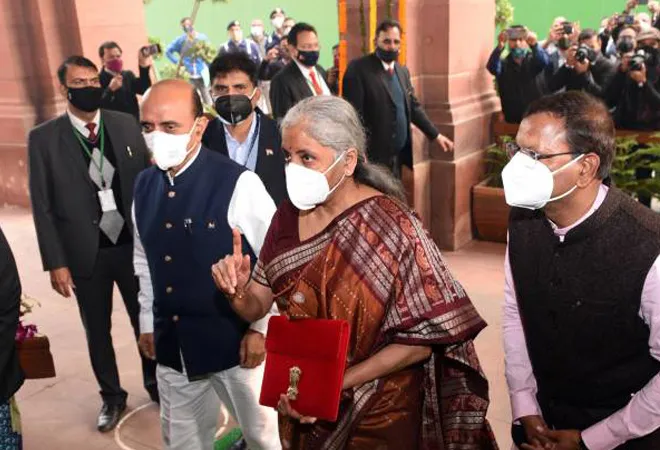-
CENTRES
Progammes & Centres
Location
The National Budget is rooted in the assumption that the economy has recovered from the dent inflicted by the pandemic, however, the statistics beg to differ.

Never before has a Union Budget been presented with a future planning for next 25 years, but that has happened this year. Coining this period towards the centenary of Indian independence as “Amrit Kaal”, the Finance Minister (FM) unveiled a grand vision for India@100.
This unprecedented attempt could have been sufficiently praised and lauded in some other time, but the current predicament of Indian economy is bound to make any independent observer full of scepticism. The world is still going through an epochal pandemic, major economies are still reeling under the impact, and India is no exception. So, the timing of inaugurating such a grand vision seems premature, to say the least.
The world is still going through an epochal pandemic, major economies are still reeling under the impact, and India is no exception.
Under the circumstances, one cannot help but recall the oft-repeated quote by John Maynard Keynes, arguably the greatest economist of 20th century— “But this long run is a misleading guide to current affairs. In the long run, we are all dead. Economists set themselves, too easy, too useless a task if in the tempestuous seasons they can only tell that when the storm is long past the ocean is flat again”. Keynes wrote this in “A Tract on Monetary Reform”, published in 1923.
This 25 year-long vision statement embedded in the budget practically assumes that Indian economy has already recovered. The revenue receipts of Central government, both tax and non-tax, have exceeded last year’s budget estimates—buoyed by marked improvements in GST collection this year (Table 1). Beating the budget revenue estimates (BE) this financial year, therefore, is perceived as a strong evidence of recovery.
| TABLE 1: Budget at a glance (in INR crore and % of GDP) | |||
|
2021-22 Budget Estimates |
2021-22 Revised Estimates |
2022-23 Budget Estimates |
|
| Revenue Receipts | 1788424 | 2078936 | 2204422 |
| (a) Tax Revenue (net to centre) | 1545396 | 1765145 | 1934771 |
| (b) Non-tax Revenue | 243028 | 313791 | 269651 |
| Capital Receipts | 1694812 | 1691064 | 1740487 |
| Total Receipts | 3483236 | 3770000 | 3944909 |
| Total Expenditure | 3483236 | 3770000 | 3944909 |
| (a) On Revenue Account | 2929000 | 3167289 | 3194663 |
| of which - | |||
| Interest Payments | 809701 | 813791 | 940651 |
| Grants in Aid for creation of capital assets | 219112 | 237685 | 317643 |
| (b) On Capital Account | 554236 | 602711 | 750246 |
| Revenue Deficit |
1140576 (5.1) |
1088352 (4.7) |
990241 (3.8) |
| Fiscal Deficit |
1506812 (6.8) |
1591089 (6.9) |
1661196 (6.4) |
|
* Deficit figures in parenthesis are as a percentage to GDP. Source: Budget documents, 2022-23 |
Aided by an increase in government revenue, revenue deficit now stands at 4.7 percent of GDP in revised estimates while 2021-22 budget document estimated revenue deficit to be 5.1 percent of GDP. Total expenditure now matches total receipts in 2021-22 revised estimates (RE) at INR 37.7 lakh crore. Interest payments have increased this fiscal, but so did capital expenditure. Increase in capital expenditure is touted in the Budget Speech as the first step towards a prosperous India in 2047. The capital expenditure is at INR 602,711 crore in 2021-22 RE (Table 1). However, this figure includes loans to Air India for settlement of past liabilities not backed by assets, amounting to INR 51,971 crore. Excluding that, capital expenditure in RE is projected at INR 550,740 crore, less than BE capital expenditure at INR 554,236 crore.
An increase in revenue receipt could have been utilised in proportionate increase in allocations, particularly in social sector expenditures like health and education. Instead, the advantage is used to keep the fiscal deficit around BE target of 6.9 percent of GDP.The fiscal deficit in BE 2022-23 is projected at 6.4 percent of GDP—in line with the broad fiscal consolidation path that proposed to bring the deficit down to 4.5 percent of GDP by 2025-26.
An increase in revenue receipt could have been utilised in proportionate increase in allocations, particularly in social sector expenditures like health and education.
In a nutshell, the budget asserts that Indian economy is out of the woods even though the COVID-19 pandemic is not yet over. An increase in the revenue is treated as the evidence to that, and keeping the deficit lower is preferred over alternative deficit financing views.
Budget conversations have revolved around “getting back to the pre-pandemic level”. But what is this pre-pandemic level? Latest first revised estimate has brought down GDP growth rate to 3.7 percent in 2019-20. GDP growth rates kept on falling since 2015-16 and it was the lowest in 2019-20. That is the “pre-pandemic level”.
| TABLE 2: Share in GDP and growth rates of 2021-22 GDP components with respect to 2019-20 components (in %) | |||
| 2021-22 Growth Rate with respect to 2019-20 (%) | Share in GDP (%) | ||
| 2019-20 | 2021-22 | ||
| Private Final Consumption Expenditure (PFCE) | -2.9 | 57.1 | 54.8 |
| Government Final Consumption Expenditure (GFCE) | 10.7 | 10.6 | 11.6 |
| Gross Fixed Capital Formation (GFCF) | 2.6 | 32.5 | 32.9 |
| Exports | 11.1 | 19.4 | 21.3 |
| Imports | 11.8 | 22.8 | 25.1 |
| GDP | 1.3 | 100.0 | 100.0 |
|
* 2019-20 figures are actuals; 2021-22 figures are First Advance Estimates. Data source: Ministry of Statistics and Programme Implementation (MoSPI) |
If 2021-22 (first advance estimates) figures are compared with this “pre-pandemic level” 2019-20 figures, then GDP growth rate in two years is a meagre 1.3 percent. Investment (GFCF) barely revived at 2.6 percent, government expenditure (GFCE) did its best to keep the GDP level respectable, exports growth steadied—a bit unexpectedly but imports grew more (Table 2). More concentrated focus on exports in this year’s budget could have been more beneficial than any two and half decadal vision. Global inflationary pressure, led by rise in oil prices, still poses a credible threat on import bills.
More concentrated focus on exports in this year’s budget could have been more beneficial than any two and half decadal vision.
However, the most important element is consumption (PFCE). Growth rate is still negative at -2.9 percent and presents the real evidence that Indian economy is yet to revive and reach a sustainable growth path. Lower share of PFCE in 2021-22 GDP at 54.8 percent, compared to 57.1 percent in 2019-20, reaffirms this fact. This signifies persistence of depressed demand and existence of low purchasing power in the economy. Continued subdued demand of two-wheelers, for example, provides another pointer.
Cutting down allocation for MGNREGA from INR 98,000 crore in 2021-22 RE to INR 73,000 crore in 2022-23 BE symbolises the prevalent dominant revival belief within government. The distress in economy, coupled with twin emerging divides of rich-poor and formal-informal, warrants continuance of welfare schemes that brought some relief to the general populace. Unfortunately, the government has decided to fix its gaze on a future that will come after 25 years.
The views expressed above belong to the author(s). ORF research and analyses now available on Telegram! Click here to access our curated content — blogs, longforms and interviews.

Abhijit was Senior Fellow with ORFs Economy and Growth Programme. His main areas of research include macroeconomics and public policy with core research areas in ...
Read More +